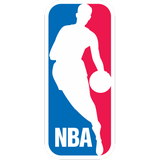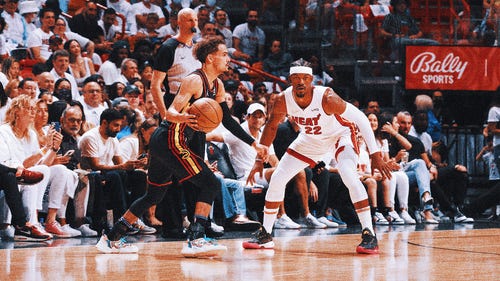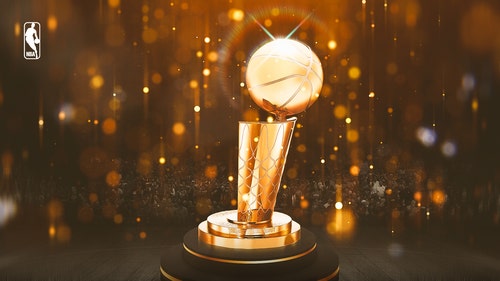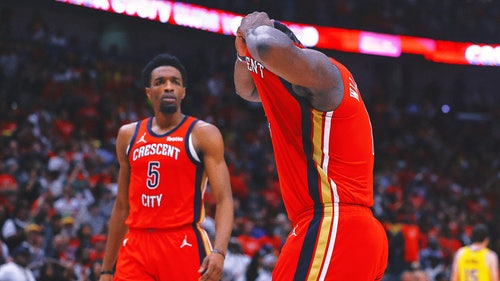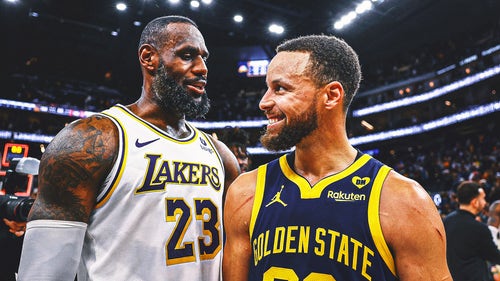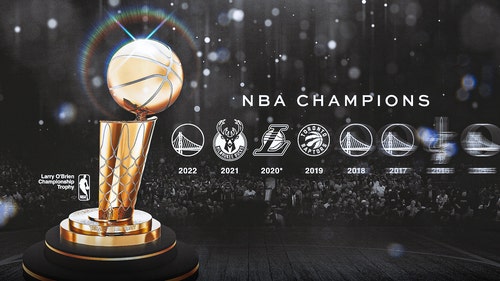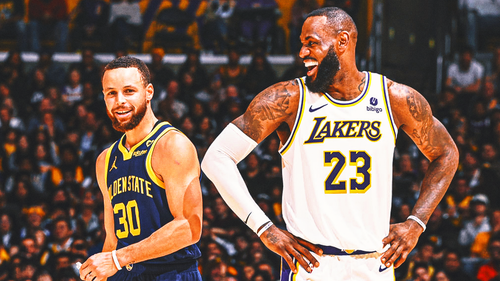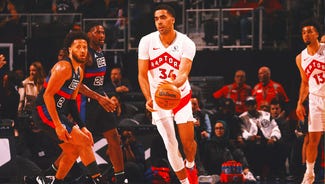
NBA Mock Draft 1.0: Paolo Banchero, Jabari Smith top list
By Jason McIntyre
FOX Sports Betting Analyst
The 2021-22 men's college basketball season is officially in the books, which means it's now time for fans to shift their focus to the upcoming NBA Draft.
We’re three months away from draft night, but after a rollicking NCAA Tournament, hoops are still top of mind. I released my 2022 NBA Draft Big Board this past summer, and many of those names remain on top following standout seasons.
It's time for my 2022 NBA Mock Draft 1.0.
The final draft order won't be set until the lottery May 17 — but let's take stock of where all 30 teams stand today.
Let's dive in.
1. Orlando Magic: Paolo Banchero, forward, Duke

Banchero has a frame that could rival a young Karl Malone, but with the quickness and skill of a wing who can take anyone off the dribble from the 3-point line. I compared his passing to Boris Diaw on my Big Board in July. He’s not the skywalker that Blake Griffin was, but he can be that physical and overpowering.
Banchero shot only 31% from deep, but it’ll be interesting to see if teams envision him as a big four — or can he play center? Bam Adebayo measured a hair under 6-foot-10 but had a 7-foot-2 wingspan. Banchero was unstoppable down the stretch in the NCAA Tournament, and he’s going to be a sizable favorite to win Rookie of the Year.
2. Houston Rockets: Jabari Smith, forward, Auburn

Smith’s worst game of the season came in the Tigers' season-ending loss to Miami (3-16 FG, 1-8 3-pointers), in which he settled for jumpers instead of trying to push the Hurricanes around in the paint. The comparisons to Chris Bosh are obvious, and after one year at Georgia Tech, Bosh went to the NBA and averaged a modest 11-7 at age 19. By his fourth year in the league, he averaged 22-10 and carried the Toronto Raptors to the playoffs. And Bosh wasn’t even a 3-point shooter.
The 6-foot-10 Smith made 79 3-pointers as a freshman and shot 42% from deep. The history of 6-10 players making 75 3-pointers in a season is … has it been done before? There’s a decent case for Smith to go first overall. But whether he wants to bang inside will be questioned, as he had only two 20-10 games this season.
3. Detroit Pistons: Chet Holmgren, F/C, Gonzaga

This will be the most divisive high pick debate since 2013, when Anthony Bennett somehow went first overall. Only one player in the top 10 from that draft has made an All-Star Game. Holmgren will be a polarizing figure because he has been pushed around at times, despite putting up gaudy stats in the WCC. But the draft isn’t about what players are now; it’s about what they can be.
Holmgren turns 20 in May, and in two years, will he be up 20 pounds? He was one of the most efficient interior scorers in the country this past season. He shot 39% on 3-pointers and 74% inside the arc. If he faced a full plate of Memphis and Arkansas-type defenses all year, what are those stats like?
A college basketball coach texted me that Holmgren shouldn’t go in the top five. But he’s 7 feet tall and has a feathery touch. If you see some Kristaps Porziņģis in his game, try to ignore the foot injuries that have derailed the career of the 7-3 All-Star.
4. Oklahoma City Thunder: Bennedict Mathurin, wing, Arizona
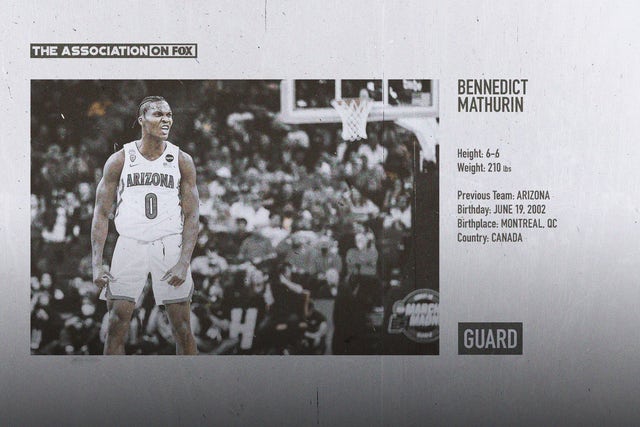
Mathurin was a lottery pick before the season on my big board, but his late-season tear propelled him into the top five. He shot 37% on six 3-point attempts per game, and he was third on his team in rebounds and assists. And by the way, Mathurin won Pac-12 Player of the Year as well.
He’s a slightly bigger version of Victor Oladipo, very explosive and also capable of creating. I’ve got his ceiling higher than that of the top wing from last year’s draft, Jalen Green.
5. Indiana Pacers: Keegan Murray, forward, Iowa

This is the highest the Pacers have drafted in more than three decades, and Murray is a perfect fit alongside Myles Turner up front. The mid-market Pacers need to get back to the playoffs, and drafting an 18- or 19-year-old project doesn’t immediately help.
Murray, who shot 39% from deep this season, turns 22 in August. If you surround Turner with Murray, Tyrese Haliburton, Malcolm Brogdon and Buddy Hield, you’ve got four shooters and a rim protector. If you want Jaden Ivey here and envision pushing Haliburton to the point, find a taker for Brogdon and the three years and $67 million he has left on his deal.
6. Portland Trail Blazers: AJ Griffin, wing, Duke

Griffin is an offensive machine who shot 46% on 3-pointers and could fit nicely at small forward alongside Anfernee Simons and Keon Johnson, assuming Damian Lillard is on the move. Griffin’s feel for the game defensively — his dad is a coach on the staff of the Raptors — along with his length should make him a terrific defender.
If he had gone to 90% of schools in America, he’d have been the No. 1 option, instead of the fifth-leading scorer (10.5 PPG). Maybe it’s the Duke offense, but Griffin didn’t do much creating off the dribble, generating just four assists in his last eight games. Let’s see what teams find in his medicals, as knee and ankle injuries slowed him the past couple of years.
7. Sacramento Kings: Jaden Ivey, guard, Purdue

Would the Kings draft a guard in the lottery for the third year in a row? They already had to trade Haliburton to get more minutes for Davion Mitchell, but how do you pass up Ivey, one of the most explosive athletes and scorers in college basketball? I’m as bullish on Ivey as anyone, but his shortcomings as a prospect were on display in the NCAA Tournament.
Yes, the lane was clogged, but having twice as many turnovers as assists is a red flag that he isn't much of a creator in the half court. I think he’s solidly in the 5-10 range, and the biggest concern is his lack of defensive intensity — or interest, really — if he doesn’t get the ball for stretches.
8. New Orleans Pelicans (via Los Angeles Lakers): Tari Eason, forward, LSU

Eason is foul-prone but oozing with talent. He scored 18 points in 19 minutes in the NCAA Tournament loss to Iowa State but also fouled out in 13 minutes against Kentucky. Eason doesn’t have a natural position yet, but the Cincinnati transfer projects as a small-ball 4. He shot 35% on 3-pointers, attempting only 2.4 per game, but the fact that he shot 80% from the line bodes well. Easton was 10th in Ken Pom POY standings.
The LSU forward ranked 12th in the country in steal percentage (4.51), a stat usually dominated by guards. No other player 6-8 or taller ranked in the top 50. Eason also battled hard against Banchero in high school, and there’s no backing down in him. One mild concern is whether his quick/power game at 6-foot-8 translates to the NBA.
9. San Antonio Spurs: Johnny Davis, wing, Wisconsin

The ankle injury Davis suffered in the regular-season finale carried over, as he shot just 15-for-55 (27%) in the postseason. He was 4-for-22 from deep, including 0-for-7 in the Iowa State loss (sample-size alert). The Big Ten Player of the Year is a fluid big guard/small forward who must improve as a shooter (30% on 3-pointers) to potentially reach All-Star levels in the NBA.
Physically, he reminds me of Norman Powell, the former UCLA guard who took a few years to develop a 3-point stroke and become an 18 PPG scorer. Davis is a high-IQ player who would fit neatly into the Spurs' system.
10. Washington Wizards: Shaedon Sharpe, guard, Kentucky

Sharpe is the biggest mystery of the draft. The five-star recruit and consensus No. 1 player in the Class of 2022 reclassified and went to Kentucky — but didn’t play. Reports out of Lexington are that he was dominant at practice and if he declares for the draft, he’s going in the lottery. At 6-foot-6, he’s got the total package, and the draft has always favored players who have less tape on them.
11. Portland Trail Blazers (via New Orleans): Jalen Duren, center, Memphis

At 6-11, 250 pounds, Duren was a force in the middle, tearing up the AAC (12 PPG, 8.1 RPG, 59% FG). Against Gonzaga’s big frontline, he got in foul trouble, played 19 minutes and shot 3-for-11. Duren ranked 30th in the country in shot-block percentage.
At best, is he a slightly smaller version of Andre Drummond? Maybe Derrick Favors? One of the youngest players who can enter the draft, Duren would be well-advised to improve his pick-and-pop game and get in the mold of Al Horford. If he did so, he would contend for the No. 1 spot in 2023. But it's extremely unlikely that happens.
12. New York Knicks: TyTy Washington, guard, Kentucky

Washington might fall into the "only guy to stop him was Calipari" camp, which also includes Devin Booker and Jamal Murray. Where was Washington in the loss to Saint Peter’s? He shot 2-for-10, didn’t get to the foul line and had five points and one assist. He was on the older side as a freshman (20).
Washington is not a true point guard and not big enough (6-foot-3) to be a combo guard. In an extremely weak point guard draft, if he can sell teams that he’s a PG, he might top the list. The NBA comp that comes to mind isn’t sexy, but this guard did have a 15-year NBA career: Jarrett Jack.
13. Charlotte Hornets: Mark Williams, center, Duke

Few players have seen their stock rise in March like Williams, who suddenly projects as a rim-running big in the mold of Clint Capela or Robert Williams. His rim projection has been outstanding — four blocks per game in the tournament — and he ranked 16th in the country in blocked shot percentage (11.7).
The 7-foot Williams shot 72% from the field (fifth in the nation). Given the way Robert Williams has turned the Boston Celtics' defense into a juggernaut, don’t be surprised if the bouncy Williams starts to get some top-10 love.
14. Atlanta Hawks: Jeremy Sochan, forward, Baylor

Sochan was a four-star recruit who was born in Oklahoma, grew up in England and played basketball in Germany during the pandemic. His mother is Polish, and he played for the Polish national team in the FIBA championships. Sochan (6-foot-9) has the frame of Kyle Kuzma (but shot only 29% on 3-pointers), and his 7-foot wingspan has helped him become a plus defender for the Bears.
He was the Sixth Man of the Year in the Big 12. Expect his stock to rise as the draft nears. The Hawks love former No. 4 overall pick De'Andre Hunter, but he hasn’t been able to stay healthy, and Sochan could be drafted to one day supplant Hunter.
15. Oklahoma City Thunder (via LA Clippers): Dyson Daniels, wing, G-League

The 19-year-old Australian prospect has struggled at times in the G-League, shooting just 44% and a woeful 25% from deep. But he’s a long, fluid, 6-foot-6 wing just scratching the surface. Squint, and the Haliburton comparisons are visible from watching Daniels play multiple positions. The stats would have looked better had he attended college, but he was going up against guys who were in the NBA and trying to get back, as well as top-notch former college players.
Don’t dismiss the G-League stats: Jonathan Kuminga put up modest numbers last year and is a heavy rotation player for the Warriors, one of the best teams in the West.
16. Houston Rockets (via Brooklyn Nets): Ochai Agbaji, SF, Kansas

Agbaji was a first-team All-American and Big 12 Player of the Year. He's a rare senior who could go in the first half of the first round. Agbaji turns 22 this month, and the stigma against 22-year-old players in the draft is very real. All three of them fell a bit from pre-draft expectations in 2021 (Corey Kispert, Chris Duarte, Davion Mitchell). Agbaji has the tools to be a solid pro, and he has the length to be an above-average wing defender.
The Desmond Bane comparisons are a tad ambitious, though. I think he’s more of a Randy Foye-type guard/wing hybrid.
17. Indiana Pacers (via Cleveland Cavaliers): Malaki Branham, guard, Ohio State

Few players have seen their pro fortunes shift as dramatically as the 6-5 freshman from Columbus, Ohio. For the first two months of the season, he scored double-digits once and got to the foul line a total of six times. Then the calendar turned to 2022, and in his first January game, he had 35 points against Nebraska. Later, he scored 27 on Indiana, then 31 against Illinois before he capped the year as Ohio State’s leading scorer with 23 points in the NCAA Tournament loss to Villanova.
He can score at all three levels, and if you remember how Buckeye D’Angelo Russell soared during the pre-draft process, don’t rule out Branham crashing the lottery.
18. Minnesota Timberwolves: Jaden Hardy, guard, G-League

Hardy was a five-star prospect who picked the G-League over UCLA and Kentucky. He put up solid numbers in the G-League — 19.8 PPG, 5.1 RPG — but then you drill down and see that he did that while shooting 35% from the field and 26% from deep. He did hit 88% of his free throws, but Hardy is all gas, no brakes, a live wire offensively with supreme confidence.
If he went to college and had to play in the structure of Purdue’s system, would he have had a season like Ivey? Because offensively, they have some similarities. Hardy could rise in the draft process, but the interview process will be one to watch.
19. San Antonio Spurs (via Toronto): Ousmane Dieng, F/C, New Zealand Breakers

The 18-year-old from France will turn 19 before the draft, and his solid season in one of the best international leagues on the planet has solidified his spot in the first round and possibly the lottery. At 6-10, he’s averaging a modest 7.8 PPG while playing 20 minutes per night. He projects as a small-ball 4, perhaps in the mold of Channing Frye, the former Arizona big man who came into the league as a post player and five years later became a prolific 3-point shooter in Phoenix.
Dieng is skilled off the dribble, quick for his size and switchable on defense, a coveted trait.
20. Chicago Bulls: Kennedy Chandler, guard, Tennessee

Chandler ranked 36th in the country in assist rate, the highest of any lottery prospect, and 30th in steal percentage. Those are great attributes that will make up for his deficiencies in other areas. Chandler is only 6-foot, but if he were 6-3, you’re looking at him maybe being a top-five pick. His shooting is a question, as his 38% mark from deep was on only 3.8 attempts per game, and his 60% mark from the foul line is a problem. He had only three 20-plus-point games this season.
The absolute best-case scenario if he improves his shooting is he’s a Chris Paul-type defender and floor general who can score. He was a two-time Mr. Basketball in the state of Tennessee.
21. Memphis Grizzlies (via Utah): Nikola Jović, forward, Serbia

The Grizzlies are flush with money in free agency and short on playing time, given how loaded their rotation is. This feels like a stash pick, and Jović makes a ton of sense. Yes, he’s Serbian, and yes, he’s one letter off from having the same name as last year’s NBA MVP.
At 6-10, 205 pounds, Jović is a promising wing playing for Mega Mozart in Serbia. He finishes great around the rim, and one more year overseas would enable him to enter the league closer to 220 pounds to deal with the rugged NBA.
22. Denver Nuggets: Patrick Baldwin Jr., forward, Milwaukee

Baldwin had an offer from Duke, but chose to play for his father at Milwaukee. It turned out to be a disaster, as injuries wrecked his season. But if the Nuggets are looking for Michael Porter Jr. insurance, they could buy low on Baldwin, who didn’t put up very impressive stats but played in only 11 games and was the top priority of every defense the Panthers faced.
Baldwin won’t turn 20 until the NBA season begins, and his slender, 6-9 frame projects him at multiple positions on both sides of the floor.
23. Brooklyn Nets (via Philadelphia 76ers): Jean Montero, guard, Overtime Elite

The Nets are going to be in the market for a point guard, given the ongoing situation with Kyrie Irving. Montero won’t be 19 when the draft arrives, so there’s a chance Kevin Durant could push for a more ready-made point guard — unless, of course, Ben Simmons assumes that role. There are lots of questions in Brooklyn. Same deal with Montero, a point guard with the speed of Derrick Rose who brings a lot of offense to the table but not much defense.
He’s not even close to a finished product and could spend some time in the G-League as a rookie.
24. San Antonio Spurs (via Boston): Hugo Besson, guard, New Zealand Breakers

After a fantastic season in France’s second division, the 6-3 point guard went to the NBL and instantly was one of the top first-year players. Besson is averaging 14.4 PPG and turns 21 this month, making him a veteran floor general in this draft, compared to the freshmen from college. He is strong with the ball operating out of the pick-and-roll and a good shooter off the dribble.
Besson reminds me of a bigger Luke Ridnour, the crafty Oregon guard who averaged double-figure scoring for seven years in the NBA. Gregg Popovich will love Besson.
25. Golden State Warriors: Blake Wesley, guard, Notre Dame

A fringe top-100 player coming out of high school a year ago, Wesley showed up in South Bend and was a factor from the first game of the season, when he dropped 21 points. He had eight games of 20-plus points. His penchant for getting to the foul line balances out his 30% shooting from deep (including 0-for-8 in three NCAA Tournament games).
A plus defender who led the team in steals, the 6-5 Wesley — only 19 years old — will have a real opportunity for playing time sooner than later wherever he goes.
26. Dallas Mavericks: Trevor Keels, guard, Duke

It’s not that his stock has fallen since the 25-point opening night against Kentucky; it's that the Blue Devils went in a different direction with sophomore Jeremy Roach at point guard.
Keels is still a young 18 — he won’t even be 19 at the draft — and if he stays in Durham, there’s a chance the PG job is his. If that happens, then he goes in the lottery or top 10 in 2023. It's tough to make a case for that now, especially with his shooting percentages cratering (41/31/68).
27. Milwaukee Bucks: Caleb Love, guard, North Carolina

A top-20 recruit coming out of high school, Love sputtered as a freshman and was good as a sophomore — but not worthy of the three All-ACC teams. He showed them in March, with 23 points vs. Marquette and 30 points vs. UCLA, his two highest-scoring games of the year. Love tormented the Bruins from deep, and he’s an 86% free-throw shooter.
He shot only 37% on 2-pointers this season, and he isn't a true point guard, which is why he isn’t yet in the discussion for the lottery.
28. Miami Heat: Christian Koloko, center, Arizona

Twenty years ago, when centers mattered, Koloko would have been a lock for the top 10, probably the top five. He made a quantum leap from his sophomore year (5.3 PPG, 4.8 RPG) and became one of the best big men in the country by March. He turns 22 in June, so he’ll probably enter the draft and capitalize on his strong end to the season, but he still has work to do if he wants to stay in the first round.
Has the 22-year-old center already reached his max potential, unlike the 18-year-old Duren? Koloko is an elite rim protector, but he did get pushed around on the defensive glass against TCU and Houston. He also had three games of four-plus assists this season, so the passing ability is there.
29. Memphis Grizzlies: Kendall Brown, wing, Baylor

A consensus top-15 recruit a year ago, Brown had a so-so freshman year (9.7 PPG, 63% on 2-pointers), but he’s still in the first-round mix because athletic, 6-8, switchy wings are very hard to find. He had a 10-assist game in November in which he displayed some point-forward abilities, and he had two double-doubles in Big 12 play.
Brown isn’t much of a 3-point threat yet (only 14 made), but he’s only 18 (19 in May), and you can easily see him being a 3-and-D wing in the NBA by 21. If you look at his tape against Oregon — five dunks, 17 points, dominant around the rim and active defensively — you wonder why he’s not a lottery lock.
30. Oklahoma City Thunder (via Phoenix Suns): Dalen Terry, wing, Arizona

I couldn’t leave him off my mock because you know how much NBA teams covet long wings who can play defense and hit 3-pointers. In the modern NBA, that’s everyone’s biggest need.
Becoming a full-time starter this year, Terry averaged only 8 PPG but was second on the team with 3.9 APG and led the team in steals. Let’s see how he measures at the combine. Because if his wingspan is over 7 feet (his listed height is 6-foot-7), you could make a case that his best-case scenario is Mikal Bridges.
Jason McIntyre is a FOX Sports gambling analyst, and he also writes about the NFL and NBA Draft. He joined FS1 in 2016 and has appeared on every show on the network. In 2017, McIntyre began producing gambling content on the NFL, college football and NBA for FOX Sports. He had a gambling podcast for FOX, "Coming Up Winners," in 2018 and 2019. Before arriving at FOX, he created the website The Big Lead, which he sold in 2010.
